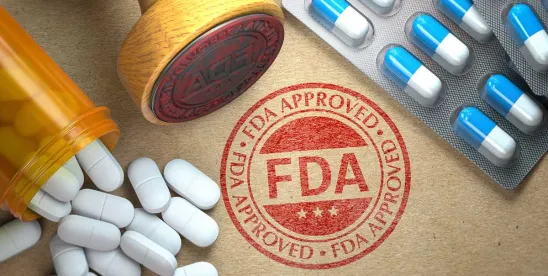FDA’s PreCheck Program Seeks to Facilitate Domestic Drug Manufacturing
What is happening: On August 7 the agency announced a new program, called FDA PreCheck, to provide drug manufacturers with earlier and more frequent interaction with FDA on manufacturing facility design and construction. The intent of the program is to accelerate drug company efforts to establish or expand domestic manufacturing operations.
The PreCheck program consists of two phases:
- The Facility Readiness Phase gives manufacturers opportunities for FDA feedback during a facility’s “critical development stages,” which include design, construction, and preproduction stages. It appears that these preoperational reviews duplicate an existing option for industry to request FDA feedback on construction plans (see previous policy here). Under PreCheck, the agency will also be encouraging participating manufacturers to submit a Drug Master File containing detailed information about the facility that can then be referenced in product-specific marketing applications.
- The Application Submission Phase aims to make development and review of the chemistry, manufacturing, and controls (CMC) module of a product’s marketing application more efficient through preapplication meetings and timely feedback.
FDA opened a docket to accept stakeholder comments on the program (due by October 30, 2025) and scheduled a public meeting for September 30, which can be attended either in person or virtually.
Why it matters: FDA’s stated goal is to accelerate onshoring of drug manufacturing by providing facility design guidance and, ultimately, greater regulatory predictability for manufacturers. The program responds in part to President Trump’s executive order on reducing regulatory burdens to promote domestic production of critical drugs and biologics, although PreCheck’s impact on achieving that goal is uncertain. Greater agency interaction during the facility design and construction phase could mitigate certain regulatory compliance issues, but the program may stretch the boundaries of FDA’s human resources. As announced, the PreCheck program seems of limited value to manufacturers as the agency does not employ engineering or construction experts, so any FDA investigator feedback on facility-based cGMP matters may not reflect other important considerations. For example, cGMP compliance is highly dependent on actual practices within an operational facility as well as the relevant written policies and procedures, which would not be addressed in PreCheck-related feedback.
With respect to the program’s Application Submission Phase, moreover, additional CMC meetings appear to have little value as drug sponsors currently have multiple opportunities to request CMC meetings with FDA throughout the clinical development process. It also is unclear how a manufacturer that is not the sponsor for drug development and does not plan to submit any future marketing applications — e.g., contract manufacturing organizations (CMOs) — would take advantage of the second phase of PreCheck. CMOs presumably could participate in the Facility Readiness Phase, but FDA has not indicated whether a manufacturer could participate in one phase and not the other.
Who may be affected: The FDA PreCheck program will most directly affect drug manufacturers looking to establish or expand operations in the United States, including (presumably) CMOs that produce drugs and biologics for the companies engaged in drug development. Manufacturers designing facilities for specific drug or biological products or supporting supplemental marketing applications to take over manufacturing for already approved products will likely benefit most from the program. It’s also important to keep in mind that designing a manufacturing facility in accordance with FDA’s feedback under the PreCheck program will not insulate the facility from future inspectional observations of noncompliance.
Ultra-Processed Foods in the Spotlight: Federal Agencies Seek to Create a “Uniform Definition”
What is happening: On the heels of the Make America Healthy Again (MAHA) Commission’s first report, which we highlighted in a previous newsletter, FDA, its parent agency the Department of Health and Human Services (HHS), and the US Department of Agriculture (USDA) have jointly issued a request for “data and information to help develop a uniform definition of ultra-processed foods (UPF or UPFs).” The solicitation includes a specific list of questions; responsive comments should be submitted by September 23, 2025.
Why it matters: Although the science is far from settled and research is still needed to tease out which food ingredients or processes may be underpinning observational study results that link UPFs to poor health outcomes, the May 2025 MAHA Report called out the increasing prevalence of UPFs in American diets as a root cause of high rates of chronic health conditions in children. FDA, HHS, and USDA are building on the report’s conclusions by seeking to more clearly and consistently define UPFs in future “research and policy,” with the eventual goal of “addressing health concerns associated with the consumption of UPFs.” The agencies do not mention specific plans for how they might use a consensus definition of UPFs in the future. However, various public policy decisions or future regulatory actions — such as mandatory labeling requirements — could stem from a universally recognized UPF definition.
Who may be affected: For years food manufacturers have defended product liability lawsuits alleging that one or more UPFs caused a consumer’s obesity or diabetes, with courts typically dismissing such claims due to the obvious health risks associated with eating high-fat, high-sodium, or high-sugar foods. In short, manufacturers do not have a duty to specifically warn consumers that “junk food” is not nutritious or could cause chronic health problems when consumed in excess. The lack of a universally accepted UPF definition has also helped defendants in such lawsuits by undercutting certain causation arguments put forward by consumer-plaintiffs. A federally recognized definition for what constitutes a UPF, irrespective of how FDA and its sister agencies ultimately deploy that definition, may have an adverse impact on defense arguments in this flavor of product liability litigation. It may also strengthen more novel theories of liability for nonmanufacturer entities such as retailers or restaurants that sell UPFs to consumers. Given the potential paradigm-shifting nature of federal action in this space, all stakeholders should consider responding to the agencies’ request for information and data.
Medical Device User Fee Amendments (MDUFA) Kickoff Meeting Suggests Stability in the Program’s Future
What is happening: FDA held an initial public meeting on August 4 to start the negotiation process for reauthorizing the next five years of MDUFA (FY 2027 – 2032). Despite the many changes at the agency since January, comments by representatives from the agency, industry, physician and hospital associations, and patient advocacy groups were generally positive about FDA’s performance on device programs, and their comments hewed to familiar themes. Key messages coming out of the meeting included:
- Commissioner Makary’s opening remarks praised Center for Devices and Radiological Health (CDRH) Director Michelle Tarver, noted recent advances in FDA technology (i.e., Elsa, the recently deployed generative AI tool to assist agency staff), and highlighted areas ripe for further modernization.
- Director Tarver also spoke about opportunities to modernize agency resources, such as building out capabilities for considering real-world evidence in device submissions. She pointed out the Center’s need for additional personnel, particularly experts who can handle increasingly complex device reviews.
- Industry representatives from the Medical Device Manufacturers Association and AdvaMed acknowledged FDA’s achievement of recent MDUFA performance goals (the current iteration negotiated to cover FY 2022 – 2027). But they also noted that continued major increases in user fee amounts are unsustainable for manufacturers, especially when there is little information on how FDA uses the collected funds. In general, industry is hoping fees will be used to support frontline reviewers and high-quality (rather than merely fast) reviews.
- Representatives from physician, hospital, academic, and patient associations argued that FDA should use collected funds to expand other device programs and resources, such as developing policies on new clinical trial models, enhancing post-market surveillance of devices and direct-to-consumer advertising, and providing more information on device safety and efficacy to patients and providers. These stakeholders urged such improvements be implemented even if industry user fees need to be raised dramatically.
- Most of the meeting participants mentioned and spoke highly of FDA’s Total product life cycle Advisory Program (TAP) Pilot. TAP was created by FDA and industry as part of the last reauthorization cycle to provide early, frequent, and strategic communications to developers of innovative devices to get them to market — and therefore patients — more quickly.
Why it matters: The kickoff meeting provides an initial look at the interests of various stakeholders and what they hope the MDUFA negotiations achieve in terms of FDA commitments and performance goals. Commissioner Makary’s apparent support for Director Tarver and CDRH, as well as Dr. Tarver’s comments spotlighting CDRH’s focus on digitization and adding resources, indicate that FDA’s aim is to keep device programs consistent with existing user fees by supporting incremental improvements. Similarly, industry group representatives generally appear to support the status quo, but will seek further transparency on the agency’s allocation of user fees.
Other participants from physician, hospital, academic, and patient associations put forward familiar arguments about the need to expand FDA oversight of device manufacturer compliance and provide more detailed information about device safety and efficacy (including in comparison to other legally marketed devices). But because these stakeholders do not directly participate in MDUFA negotiations, it is unlikely that such initiatives will be included in the final package that will be sent to Congress in early 2026 for reauthorization next year. Notably, the meeting indicated broad support for FDA’s TAP Pilot, which could foreshadow expansion of the pilot and its eventual transition to a formal CDRH program.
Who may be affected: The MDUFA reauthorization process and eventual amendment package impact all medical device stakeholders, but this meeting is only the first step in a long process of negotiations between FDA and the device industry, as well as consultations with other stakeholders. Early indications are that the agency and industry are mostly aligned on holding the course to produce a relatively simple and straightforward amendment package for the next five-year program period. Such a result will provide additional stability for device manufacturers and industry investors.
Deregulatory Actions Gain Momentum; May Allow FDA Leeway to Promulgate New Regulations in the Future
What is happening: In July, FDA announced that it is revoking 52 individual “obsolete and unnecessary” food product standard-of-identity (SOI) regulations. SOI regulations describe in detail what a particular type of food should contain — or not contain — and establish other uniform characteristics for the food. Historically, the purpose of an SOI was to protect consumers by ensuring they are not misled or defrauded (see, e.g., this post on enforcement of the mayonnaise SOI back in 2015); they also help deter economic adulteration of food by unscrupulous actors. For the past several years, the agency has been working to modernize the SOI program to account for innovations in technology and food processing as part of a broader Nutrition Innovation Strategy.
Why it matters: While other SOI regulations have been revoked or amended in recent years, the July 16 announcement is notable for the large volume of deregulatory actions being taken concurrently by FDA. As previously reported, the Trump administration kicked off a wide-ranging, comprehensive deregulatory push seeking to identify federal regulations that may be ripe for repeal or rescission pursuant to the president’s stated policy priorities. One of President Trump’s earliest executive orders requires that for each new “regulation,” at least 10 prior regulations must be identified for repeal. FDA’s decision to revoke a whopping 52 codified SOI rules may be strategically designed to give the agency a “rulemaking credit” with the White House’s Office of Management and Budget (OMB), allowing it to issue five new regulations in the future while still remaining in compliance with OMB’s 10-for-1 directive.
Who may be affected: Food manufacturers may be the most directly affected constituents for SOI regulatory changes, as such actions may give them more flexibility in how they develop and produce the foods at issue.
On the other hand, consumers may now have to pay more attention to food ingredient declarations to ensure full awareness of what foods they are purchasing — for example, if a manufacturer decides to replace a real ingredient (previously required by an SOI) with something synthetic or with an unexpected alternative, that will need to be reflected on the label, and consumers won’t know about such changes unless they actually review the label information. If manufacturers attempt to take advantage of this shift in regulations for specific food products to introduce new or different ingredients that diverge from consumer expectations, it could lead to consumer pushback. In the short term, such attempts by manufacturers could generate an uptick in lawsuits by individuals who feel they did not get what they expected when purchasing a particular food product.
More broadly, all FDA stakeholders should be watching for new regulatory initiatives that the agency may have unlocked through its repeal of such a large number of formal rules.





 />i
/>i

